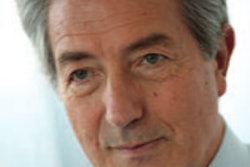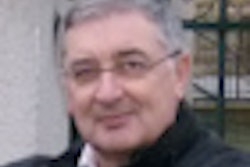
Outside of radiology, Dr. Lorenzo Bonomo's great passion in life is the mountains. Each year, he embarks on a trekking holiday with a group of fellow chest radiologists and their partners, and he also loves skiing in the Dolomites.
For the next month, however, Bonomo's attention will be firmly focused on the European Congress of Radiology (ECR), which takes place in Vienna from 1 to 5 March. As congress president, he is relishing the prospect of presiding over ECR and flying the flag for Italian radiology.
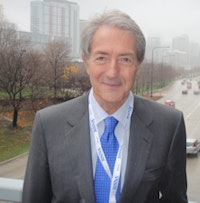 Dr. Lorenzo Bonomo
Dr. Lorenzo Bonomo
Forging closer links between radiology and radiation oncology is a driving force for Bonomo, who is chair of the department of radiological sciences and bioimaging at the Gemelli Hospital, Catholic University of Rome. This theme will figure prominently at ECR 2012.
"The special challenge we face in our department is to have radiation oncology," he noted. "We think it's important for us as diagnosticians and for them as radiation oncologists to be in the same department because imaging is playing a growing role in pre- and post-treatment oncology patients. In the future, oncologic imaging will increase more and more, and from an educational point of view, we'll have to change. Until now, we've had subspecialty training."
Bonomo's department has a cyclotron and two PET scanners run jointly by radiologists and nuclear medicine physicians for 12 hours per day, six days a week. About 28,000 PET/CT scans a year are performed. He also oversees five CT units (two 64-slice, two 16-slice, and one four-slice), and four MRI systems (three 1.5-tesla and one dedicated musculoskeletal). During 2012, he hopes to acquire a new dual-energy/spectral CT machine and a 3-tesla MR unit.
In Rome's two other university hospitals, La Sapienza and Tor Vergata, radiation oncology is also within the department of radiology, but this is not generally the case in the rest of Italy. However, Bonomo keenly supports much closer collaboration between radiation oncology and radiology, and along with Dr. Vincenzo Valentini from Rome, he very much looks forward to presiding over the ESR Meets Radiation Oncologists session, to be held on the afternoon of Friday, 2 March. He encourages all radiologists to learn about oncology through the European Society of Oncologic Imaging and become more confident about approaching cancer patients.
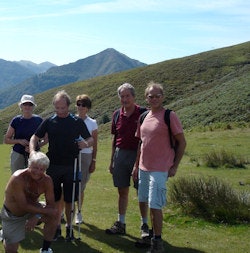 Alpine relaxation: From left to right are Dr. Pierre Schnyder from Lausanne, Diana Flower, Dr. Christopher Flower from Cambridge, Dr. Dominique Grenier, Dr. Lorenzo Bonomo, and Dr. Christian Herold.
Alpine relaxation: From left to right are Dr. Pierre Schnyder from Lausanne, Diana Flower, Dr. Christopher Flower from Cambridge, Dr. Dominique Grenier, Dr. Lorenzo Bonomo, and Dr. Christian Herold.
Overall, Gemelli Hospital has 1,800 beds, and the radiology department is the biggest in Rome and one of the largest in Italy. It has 40 full-time radiologists, 15 radiation oncologists, 10 nuclear medicine physicians, 60 radiographers, and 20 nurses. About 230,000 radiological examinations (excluding PET) are performed annually, half of which are conventional x-ray procedures. CT accounts for approximately 25% of the total examinations, and MRI accounts for 20%. When Bonomo started working there in 2003, slightly fewer than 200,000 examinations a year were performed.
He previously worked at Chieti University Hospital in the east of Italy, where he spent 27 years. He helped establish the radiology department in Chieti, and is proud that many of his former colleagues are still based there.
Bonomo is concerned about the economic crisis affecting Europe, but he does not think the current difficulties will have a major impact on the congress, not least because the need for quality education and training is still stronger than ever.
"We have to be optimistic," he said. "We have to find new innovations that will keep attracting people -- for instance, having more interactive sessions and to increase the multidisciplinary sessions. In the daily clinical practice, it is important for radiologists to discuss cases with clinicians, pathologists, nuclear medicine doctors, etc."
What's New at ECR 2012?
A major difference this year is that Thursday is now a full congress day. The scientific sessions will now start at 10.30 on the morning of 1 March, although the technical exhibition will only be open from 10 a.m. on 2 March to 2 p.m. on 5 March.
"According to our data from the last meeting, many people arrive on the day before ECR began, and they just ended up walking around the congress hall. From now on, there will be sessions for them to go to," Bonomo commented. "My advice is to get to Vienna as early as possible!"
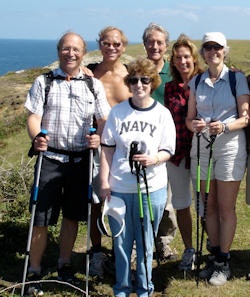 Bonomo and a group of fellow chest radiologists and their partners enjoy an annual trekking holiday in Europe. From left to right are Dr. Philippe Grenier from Paris, Dr. Christian Herold from Vienna, Dr. Theresa McLoud from Boston, Dr. Lorenzo Bonomo, Sigrid Herold, and Diana Flower.
Bonomo and a group of fellow chest radiologists and their partners enjoy an annual trekking holiday in Europe. From left to right are Dr. Philippe Grenier from Paris, Dr. Christian Herold from Vienna, Dr. Theresa McLoud from Boston, Dr. Lorenzo Bonomo, Sigrid Herold, and Diana Flower.
Two new scientific subcommittees on oncologic imaging and emergency radiology have been established, and there will be a greater emphasis on interactivity and more communication with speakers. The minicourse on controversies in abdominal imaging is an interactive session in which experts present divergent opinions, and additional minicourses include Organs from A to Z: Lung, Essentials in Oncologic Imaging (a joint course of the ESR and RSNA), Molecular Imaging, and the Beauty of Basic Knowledge: Interpretation of the Chest Radiograph.
Bonomo thinks the new subspecialty refresher courses, titled How I Report, will be of particular interest to younger delegates. The aim is to make less experienced radiologists become aware of how to report in a way that is more understandable and useful to referring physicians. Foundation courses will concentrate on ultrasound so that radiologists can carry out ultrasound scanning "better than other specialized physicians," he noted, and the importance of including ultrasound in diagnosis, along with other imaging techniques.
"Categorical courses are the backbone of the congress," he stated. "We will see the return of a very successful course that was introduced last year -- CLICK (Clinical Lessons for Imaging Core Knowledge) -- as well as two new courses, respectively focusing on emergencies in neuroradiology and on genitourinary imaging."
The guest nations at ECR 2012 will be Italy, Romania, and Egypt, which will become the first African nation to be featured in the ESR Meets initiative. The New Horizons sessions are on liver imaging, ablation beyond radiofrequency, and new insight into the vascular wall. One of the professional challenges sessions will be held jointly by the ESR and the International Commission on Radiological Protection (ICRP) and will feature staff from the International Atomic Energy Agency. The other two Professional Challenges sessions will be dedicated to the diagnosis of inflammatory conditions (a joint session of the ESR and the European Association of Nuclear Medicine) and medicolegal challenges for radiologists.
For those who are unable to attend the congress, selected sessions will be broadcast live and transmitted in real-time online. Bonomo expects this to be a very popular new feature. More details are available at myESR.org.




